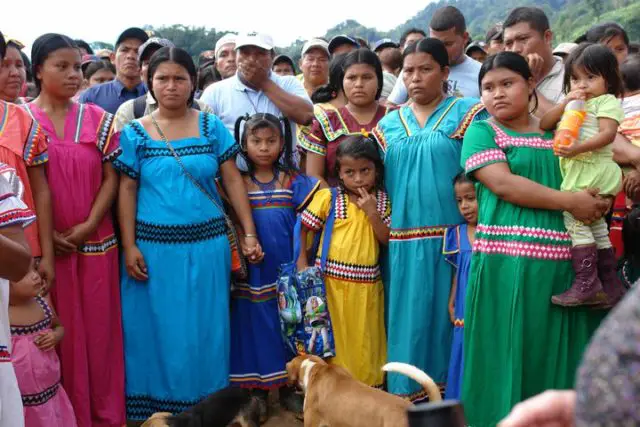
The Ngäbe-Guaymíes, inhabit several indigenous reserves in the southern part of Costa Rica, especially on the border with Panama. They form a cultural unit with the native people of the Ngäbe-Buglé tribes in Panama.
History of their artisans and cultural unity
During the European conquest of America, the Spanish came in contact to the west of Panama three different Ngabe, each with a different language. They were named by the name of its leaders: Natá, in the current province of Coclé, Parita in the Azuero peninsula, and the most famous, Urracá, in what is now the province of Veraguas.
Chief Urracá defeated the Spanish over and over again, forcing Captain Diego de Albites to make a peace agreement with him in 1522. According to the historian Fray Bartolomé de las Casas, Urracá was invited by the Spanish for a peace treaty, but he was arrested and sent to the town of Nombre de Dios, in the current province of Colón, he escaped from there and returned to the mountain, vowing to fight the Spanish to death. Keeping his oath: he and his men were so feared that the Spanish finally avoided fighting with him. Urracá died in complete freedom in 1531.
The Ngabe were divided into two main groups: those on the Atlantic coast (formerly part of Bocas Del Toro), and those from the highlands, on lands that previously belonged to Chiriquí and Veraguas.
They never gave up their independence and maintained their resistance until the fall of Spanish rule in the area. When Panama became independent from Spain and joined Colombia (19th century), the Ngabe remained in the mountains. Currently, the policy of interculturality is applied for respect to their independence.
Economy and culture.

Their main activity is subsistence agriculture of corn, rice, beans, cassava, yams, and plantain crops.
A part of the natives permanently migrated or seasonally migrates to work in the coffee plantations of Costa Rica. Other ways to earn income are working on banana plantations or selling their handicrafts at tourist sites and along the roads of Panama.
Ngabe women make, among their traditional handicrafts, items that serve for clothing their families and for sale to tourists. This includes woven vegetable fiber bags (called “kra”), colorful long women’s robes decorated with geometric patterns (“naguas”), and beaded bracelets and necklaces, formerly used as ornaments for warfare. Men weave hats out of vegetable fiber for everyday use or to sell.
The contribution of the Ngabes to our folklore is appreciated in the “kra” (called “chácara” in Spanish) and in the “Painted Hats”. Both elements have been incorporated into the clothing of our rural inhabitants.
The population of Ngabe peoples in Costa Rica is the result of the migration that began in the mid-20th century from the Ngöbe-Buglé Comarca in Panama. According to a census carried out by the National Directorate of Migration and Immigration of Costa Rica in 2012, 3,171 permanent resident indigenous people live in the national territory, located in 4 reserves: Abrojos-Montezuma, Altos de San Antonio (Coto Brus), Conteburica and Guaymí de Osa, located in the cantons of Coto Brus, Corredores and Osa.
Each October, there is a phenomenon of migration from Panama to work on the coffee harvest that lasts until March of the following year, so it is common to observe some of these indigenous people in cantons that produce this grain, such as the Los Santos, Acosta, Pérez Zeledón, Grecia, Naranjo and San Ramón area.
The enter the country through three points on the border with Panama: Paso Canoas, Limón (Sixaola), and Río Sereno (Coto Brus).
In 2018, approximately 15,000 Ngabe indigenous workers entered Costa Rican territory to collect coffee or labor in banana plantations.
As of the year 1990 and thanks to the struggle of the Ngöbebgue Culture Association, Costa Rican citizenship was recognized. Starting in 2012, the National Directorate of Migration and Aliens began to grant Ngabe immigrants temporary residence cards, to protect them from abuse and facilitate bank procedures or health care. Before, they only entered with a safe-conduct issued by the Government of Panama.

